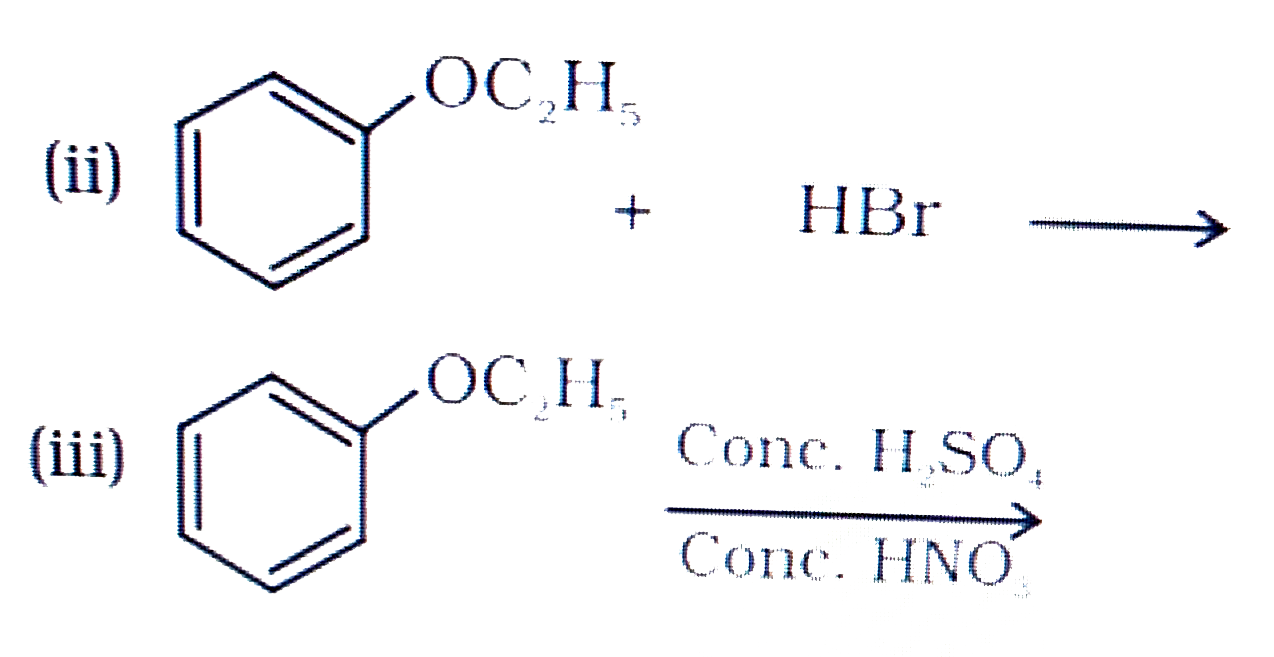Explain whether oxidation, reductio, or neither occurs in the following reactions :
(a) H2C=CH2→H3C−CH3
(b) HC≡CH→H3C−CH=O
( c) CH4→CH3OH
(d) H2CBr2→H2C=O
II. Give the structural formula for the simplest hydrocarbon in which C has a zero O.N.
Video Solution
Text Solution
(a) Reduction, because O.N. Of C changes from −2 to −3
H2C=CH2(C2H4):2x+4=0,x=−2
H3C−CH3(C2H6):2x+6=0,x=−3
(b) Neither, because O.N of C in both reactant and products is −1, i.e., no change in O.N.
CH≡CH,(C2H2):2x+2=0,x=−1
CH3OH(CH4O)=2x+4−2=0,x=−1
( c) Oxidation, because O.N of C changes from −4 to −2
CH4=x+4=0.x=−4
CH3OH(CH4O)=x+4−2=0,x=−2
(d) Neither, because O.N of C in both reactant and product is zero, i.e., no change in O.N.
H2CBr2≡x+2−2=0,x=0
CH2O=x+2−2=0,x=0
II. The simplest hydrocarbon is (HC≡CH). The number of H atoms and C atoms must be same so that their oxidation number with opposite signs would cancel.
|
Topper's Solved these Questions
- GENERAL ORGANIC CHEMISTRYBook:CENGAGE CHEMISTRYChapter:GENERAL ORGANIC CHEMISTRYExercise:Solved Example
Explore 18 Videos
- GENERAL ORGANIC CHEMISTRYBook:CENGAGE CHEMISTRYChapter:GENERAL ORGANIC CHEMISTRYExercise:Subjective
Explore 11 Videos
- CLASSIFICATION AND NOMENCLATURE OF ORGANIC COMPOUNDSBook:CENGAGE CHEMISTRYChapter:CLASSIFICATION AND NOMENCLATURE OF ORGANIC COMPOUNDSExercise:Analytical and Descriptive Type
Explore 3 Videos
- HYDROGEN, WATER AND HYDROGEN PEROXIDEBook:CENGAGE CHEMISTRYChapter:HYDROGEN, WATER AND HYDROGEN PEROXIDEExercise:Subjective Archive (Subjective)
Explore 3 Videos
Similar Questions
Knowledge Check
Following reaction:
(CH3)3C−Br+H2O→(CH3)3C−OH+HBr is an example of -AElimination reactionBFree radical substitutionCNucleophilic substitutionDElectrophilic substitutionAppropriate reducing agent for the following conversion is -
CH2=CH−CH2−O∣∣C−H→CH3−CH∘−CH2−CH2OHALiAlH4/H2OBNaBH4/H2OCNa+C2H5OHDB2H6/H+Product'C' in the following reaction is
CH3−CH=CH−CH3H3O+ −−−−→A[O] −−→B
dry HCl −−−−−−−−−→2CH3−OHCACH3− C2H5∣C∣ OCH3−OHBCH3− C2H5∣C∣ CH3−OCH3CCH3− C2H5∣C∣ OCH3−OCH3DCH3− C2H5∣C∣ CH3−CH3
Give the product of the following
(i) C6H5CH=CH2+HBr→
CH3CH2CH=CH2+HCl→
(iii) C6H5CH2CH=CH2+HBrPeroxide−−−−→
View SolutionComplete the following reactions
_S01_429_Q01.png)
_S01_429_Q02.png)
(c ) CH3CH=CH2mCPBA−−−−→AC2H5MgBr−−−−−−→H3O+B
View SolutionCarry out the following transformation in not more than three steps.
CH3−CH2−C≡C−H→
CH3−CH2−CH2−O∣∣C−CH3
View SolutionHow would you carry out the following conversions ?
(a) H3CCH2=CH2→H3C−CH2CH2CH2OH
(b) H3CCH2−CH=CH2→H3C−CH2−CH(OH)CH2OH
(c) H3CC≡CH→H3CCOCH3
(d) Br2CHCHBr2→HC≡CH
View SolutionWhat will be the product of the following reaction ?
CH3 |H3C−C−Br+Na−O−CH3→ | CH3
View Solution


